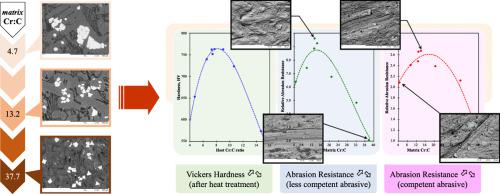Tribology International ( IF 6.1 ) Pub Date : 2021-11-14 , DOI: 10.1016/j.triboint.2021.107350 Hamid Pourasiabi 1 , J.D. Gates 1

|
Wear behavior of white cast irons (WCIs) is largely attributable to the particulate-reinforced composite phenomenon, in which both reinforcing particles and matrix play important roles. In high-Cr WCIs, matrix properties are influenced by chromium-to-carbon (Cr:C) ratio. Without a strong matrix, the carbides would not have sufficient support during the abrasion interactions. The effects of Cr:C ratio on the wear properties of plain-Cr WCIs have been only partially studied; but its effect on Nb-containing WCIs has never been explored. This work studies the influence of Cr:C ratio on high-stress abrasion performance of WCIs further reinforced by niobium carbides (NbC). The alloys covered wide range of Cr:C ratios, resulting in considerable variation in hardness — low hardness for both very-low and very-high Cr:C. Abrasion resistance was assessed by the ball mill abrasion test in quartzite and basalt, showing an optimum matrix Cr:C around 14.6 and 18, respectively. The very-high Cr:C alloy exhibited poorest resistance in both abrasives, and the very-low Cr:C alloy was second-poorest. SEM of worn surfaces revealed the effects of Cr:C ratio on the type and level of damages to microstructure, manifested by various morphologies and depths of indentations and grooves on the matrix, and various types and severities of damages to Cr-rich carbides, including micro-cutting and micro-fracture. NbC particles appeared to be protective across the full range of Cr:C ratios.
中文翻译:

基体铬碳比对碳化铌双增强高铬白口铸铁高应力磨粒磨损行为的影响
白口铸铁 (WCI) 的磨损行为很大程度上归因于颗粒增强复合材料现象,其中增强颗粒和基体都起着重要作用。在高铬 WCI 中,基体性能受铬与碳 (Cr:C) 比的影响。如果没有坚固的基体,碳化物在磨损相互作用期间将无法获得足够的支撑。仅部分研究了 Cr:C 比对普通铬 WCI 磨损性能的影响;但其对含 Nb WCI 的影响从未被探索过。这项工作研究了 Cr:C 比对碳化铌 (NbC) 进一步增强的 WCI 的高应力磨损性能的影响。这些合金涵盖了广泛的 Cr:C 比率,导致硬度变化很大——非常低和非常高 Cr:C 的硬度都很低。通过在石英岩和玄武岩中的球磨机磨损试验评估耐磨性,显示最佳基质 Cr:C 分别约为 14.6 和 18。非常高的 Cr:C 合金在两种磨料中表现出最差的抵抗力,而非常低的 Cr:C 合金次之。磨损表面的 SEM 揭示了 Cr:C 比对微观结构损伤类型和程度的影响,表现为基体上的各种形态和压痕和凹槽的深度,以及对富铬碳化物的各种类型和严重程度的损伤,包括微切割和微断裂。NbC 颗粒似乎在整个 Cr:C 比率范围内都有保护作用。极低的 Cr:C 合金排在第二位。磨损表面的 SEM 揭示了 Cr:C 比对微观结构损伤类型和程度的影响,表现为基体上的各种形态和压痕和凹槽的深度,以及对富铬碳化物的各种类型和严重程度的损伤,包括微切割和微断裂。NbC 颗粒似乎在整个 Cr:C 比率范围内都有保护作用。极低的 Cr:C 合金排在第二位。磨损表面的 SEM 揭示了 Cr:C 比对微观结构损伤类型和程度的影响,表现为基体上的各种形态和压痕和凹槽的深度,以及对富铬碳化物的各种类型和严重程度的损伤,包括微切割和微断裂。NbC 颗粒似乎在整个 Cr:C 比率范围内都有保护作用。











































 京公网安备 11010802027423号
京公网安备 11010802027423号